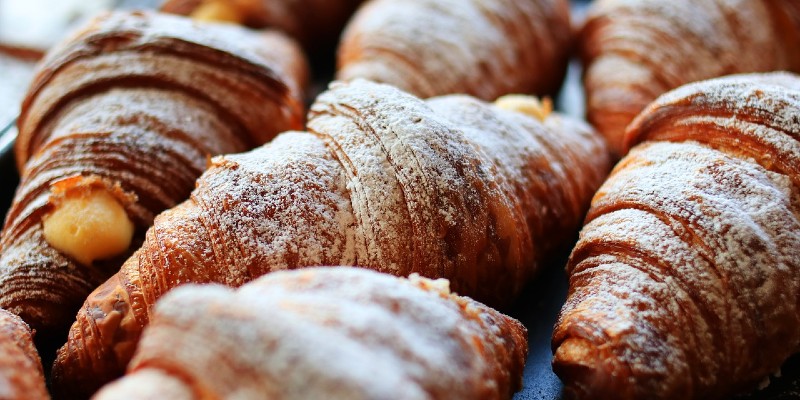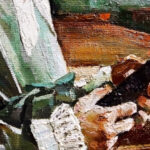I’ve always loved superficial fear, the tickle of anticipation or drop of my stomach before a book’s plot twist, a jump scare in a slasher movie. I was watching Stephen King adaptations at age nine, inhaling R.L. Stine before I finished second grade. Maybe it’s schadenfreude for those poor characters who are on the verge of decapitation or about to receive a letter blackmailing them into doing unspeakable deeds. Perhaps it’s a way for me to convert my generalized anxiety into something ephemeral that I know will dissipate when I close a book or watch the credits roll. But pathologizing aside, I have always loved edge-of-your-seat suspense, immersing myself in the unknown of a story, waiting with bated breath for what could happen next.
I am privileged to say I haven’t faced too much fear in my real life. I had a very stable upbringing, loving parents shielding me from any sort of true, desperate want. There has been one consistently tricky obstacle, though, a certain monster that I have battled with time and time again. And with irony so deliciously absurd it would fit neatly into ancient mythology, it’s something that requires me to stay alive. Food. Food has been my greatest source of fear.
***
In my debut novel Nanny Dearest, the titular nanny, Anneliese, has had a troubled upbringing. She grew up in an abusive household and, until she is hired as a nanny, has had no real agency over her life. Her mother is dead. Her father and siblings are burdens and bullies. She yearns for continued education but knows how difficult that is to obtain for a working-class individual with no support system.
When I was fleshing out her character, I knew that she needed to have something, a unique talent aside from endless caregiving in which she could revel, that could be a source of pride and a bright spot in her otherwise sallow, sad existence. I landed on cooking because I recognized that in a contained suspense novel about nannying, there would be many kitchen scenes, that it would be easy as a writer to let this character flex a domestic skill.
Anneliese is constantly creating food, in the past and present timelines, everything from tomato sauce to a multi-tiered birthday cake. It is a way for her to busy her broken mind and a task that helped me, as a writer, lubricate scenes, give her something to do with her hands as she mulls over her charge, Suzy, and the household in which she’s taken residence. As I continued describing her decadent creations, it occurred to me that these passages about fruit platters or runny eggs or homemade iced tea also served as a palate cleanser for the reader.
I deliberately wanted to write a book that did not sit well with its audience, whose prose had a slow, almost sickly, creeping sensation. I wanted the characters and their actions to be heady and volatile, their deranged states of mind echoing with readers far off the page, into their day-to-day life as they absorbed my book. If I’ve done anything right, readers should feel a sense of unease, a nagging sensation of surreality once they’re out of the characters’ heads and back to real life.
But as a writer, you can’t sustain this feeling of potent dread in every single paragraph.
Descriptions of food in Nanny Dearest, therefore, became a vehicle for readers’ comfort, a short respite from poring over a toxic, codependent relationship, death, physical and emotional abuse. I wanted food, cooking, this pastime of Anneliese’s, to be untouched by the rest of the novel’s darkness, save for one narrative-rendering scene two-thirds of the way into the book. And even that plot choice doesn’t involve imagery of rotting chicken carcasses (anyone who has read Leila Slimani’s phenomenal The Perfect Nanny knows what I’m talking about). Food, at least its physical depictions, is left pure in Nanny Dearest.
***
When I was six, I was diagnosed with hypercholesterolemia, which basically means that I had inherited the cholesterol levels of an old man. With proper management and medication, I wouldn’t drop dead of a heart attack at 35, the doctor told my parents and me. However, I was too young to go on any of the statins typically prescribed to people with high cholesterol, so ‘management’ was key. This meant that before I was reading chapter books, I was thrust with some pretty grown-up information: some foods were forbidden, even deadly. I suddenly had to avoid cheese, milk, ice cream, burgers, french fries, along with a whole host of other normal six-year-old staples. And if I didn’t avoid them I would die; the message was clear as day to little me—I had to restrict.
For many people who struggle with disordered eating, their illness begins with fat-shaming, a childhood speckled with ridicule for being a bigger size. For me, it was this diagnosis (it didn’t help that I went to an all-girls school on the Upper East Side of Manhattan, famously known for its stick-thin inhabitants). And incidentally, all those foods with high cholesterol have also been demonized by diet culture, deemed “bad” and “unclean,” foods that should be avoided at all costs if one wants to stay “healthy” (i.e., thin).
Over the next fifteen years, food would become my biggest fear, my most conniving foe. I would spend the majority of my days calculating how little sustenance I could put in my body, how many calories I could burn off, how far I could go into an 8 am school day without eating anything, my head buzzy, my muscles languid. My dinners were Lean Cuisines and Skinny Cow ice cream. At my worst, meals consisted of bubble gum and iced coffee, hunger pangs quenched by diet soda. Anything with a modicum of flavor, made with butter or oil or cream, was considered off-limits, terrifying, about to clog my arteries and make my cholesterol shoot up, my weight fluctuate to an “unhealthy” number for someone with hypercholesterolemia.
Of course, my doctor applauded me. My cholesterol numbers were low!
When I got to college, my first time living away from home, I was struck by how much people ate in a given day. Did my new friends actually eat carbs at all three meals? People actually ate three meals a day?
In the years that followed, my constraints around food slowly but surely began to ebb away. I started therapy. I came to terms with my ever-changing body. I began to read about and follow anti-diet practitioners and body-neutrality activists. I became familiar with Health At Every Size, a heavily studied public health approach that divorces weight from health.
I was introduced to Intuitive Eating, a program first designed by dietician Evelyn Tribole that teaches you to listen to your hunger and fullness cues, to eat what you want when you want, that once you let all types of sustenance into your diet (potato chips and broccoli), your fixation with food will eventually go away. I learned to notice all the ways in which the diet industry informs us to hate ourselves. I ate so many new cuisines that I finally understood why true foodies shunned my fat-free ice cream or sugar-substitute filled baked goods.
Intuitive Eating teaches that if you have a medical reason to avoid certain foods, like an allergy, you should obviously adhere to that rule. At twenty-eight, I eat as intuitively as I can within the rubric of my hypercholesterolemia (I avoid red meat except for special occasions, I rarely cook with cream or butter, I use Egg Beaters instead of normal eggs). But I’m also lucky; I’m able-bodied, so I enjoy exercising four to five times a week, which is proven to help lower cholesterol levels. Most importantly, I’m on a new, recently introduced medication that has made my cholesterol lower than it’s been my entire life.
***
I began to write Nanny Dearest in 2019. By then, I was well-versed in the tenets of Food Freedom, which made writing all those scrumptious scenes in which Anneliese is cooking even more enjoyable. Those scenes of food preparation act as a recess for the reader in a character-driven book fueled by madness. But maybe, they also act as a comfort to me, a way to remind myself that food is sustenance, food is survival. And above all food is pleasure, and it’s okay to characterize it as such, as something I love and need and like to curl up with, that gives me, in some cases, as much joy as falling in love.
Maybe, by depicting delicious food between the cracks of a psychological thriller, I’ve come more to terms with the fact that eating should not be a fearful activity, that if anything, it should serve as security, not only for my page-turning readers, but also for myself.
___________________________________


















